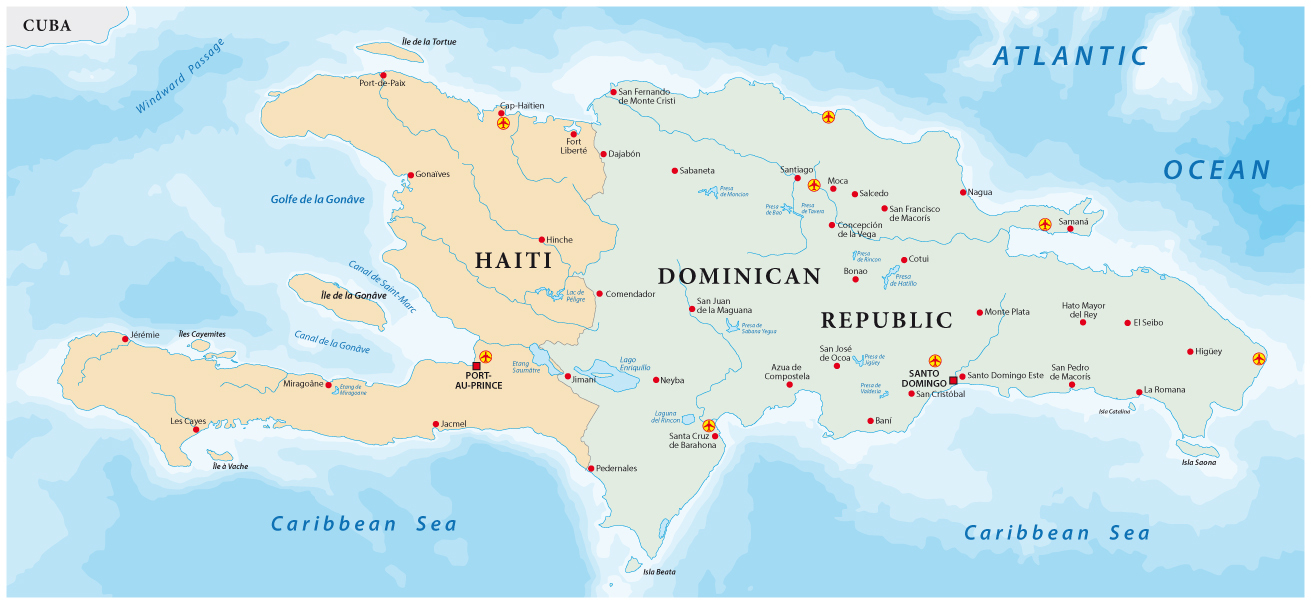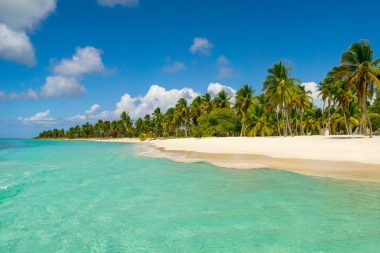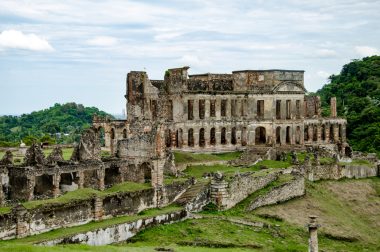
Hispaniola is the second largest island in the West Indies of the Caribbean after Cuba and is located between the Greater Antilles . It is home to the two island states of Haiti and the Dominican Republic.
Its total area is 76,500 square kilometers, of which 48,700 are in the Dominican Republic and 27,800 square kilometers in Haiti. Hispaniola is 650 kilometers long and 240 kilometers wide. It not only has the largest area of all the islands of the Antilles, but is also its most populous island with a total of more than 21 million inhabitants. The population is almost equally divided between the two island states. In the western third of Hispaniola lies Haiti and the
the remaining two-thirds area is occupied by the Dominican Republic. Due to the unequal size of the national territories, their population density differs greatly. Haiti has 352 inhabitants per square kilometre, while the Dominican Republic has only 207 inhabitants per square kilometre.
How the natives called Hispaniola

The indigenous people, the Tainos, called the island Kiskeya or Ayiti, which translates as “wonderful or mountainous land” and gave rise to today’s names “Qiusqueya” and “Haiti”. The entire island was originally called Haiti, while Quisqueya is mentioned in the lyrics of the national anthem of the Dominican Republic. Christopher Columbus landed on Hispaniola in 1492 during his conquest of paradise and gave it the name La Isla Española. Your geographical location
offered the Spanish the opportunity to push ahead with their expansion into Cuba, Mexico, Panama and South America. During the colonial period, the island was politically divided into the Spanish eastern part and the French western part. The Dominican Republic emerged from the eastern part and Haiti from the western part. Hispaniola forms the archipelago of the Greater Antilles with Cuba, Jamaica and Puerto Rico , which have only a few offshore islands. The most famous on the Haitian side are the islands
Gonâve, Tortuga and in front of the territory of the Dominican Republic the island of Saona.
Hispaniola can also boast of being home to the five highest mountains in the region in its five mountain ranges. All of them are located in the Cordillera Central, which stretches from the south coast to the northwest of the island. The Yaque is 2760m high, the Loma de la Viuda 2802m, the Loma Rucilla 3039m, the Loma La Pelona 3097m and the Pico Duarte 3098m. Parallel to the Cordillera Central, the Cordillera Septentrional runs along the north coast and then falls as the Samaná Peninsula
into the Atlantic. Between Santiago and Puerto Plata, the summit of Pico Diego de Ocampo at 1249 meters is the highest point of this mountain range. The Cordillera Oriental rises to a maximum of 736 meters in the east of the Dominican Republic. To the southwest, the Sierra de Neiba extends into Haiti as Montagnes Noires. The highest point is located at 2177 meters north of Largo Enriquillo. The mountain range in the south under the names Massif de la Selle and Massif de la Hotte forms the southwestern peninsula of Haiti.
At 2715 meters, the Morne de la Salle is the highest point of this mountain massif on the Haitian side. On the Dominican side, the mountain range rises to 2368 meters. Parallel to this runs the lowlands, which are called Plaine du Cul-de-Sac in Haiti and end in the capital Port-au-Prince.
Attractions in Haiti and the Dominican Republic
In the lowlands, there are several saltwater lakes, such as the Saumatre Lagoon in Haiti and Lake Enriquillo in the Dominican Republic. Geographically, Hispaniola is located exactly on the border of the Caribbean and North American plates and is therefore often exposed to earthquakes.
The island has four different ecoregions, of which about 50 percent are covered by wet forests and penetrate mainly at lower altitudes, but also up to altitudes of 2000 meters. 20 percent of the island is made up of dry forests in the shade of the mountains in the south and west. In the rocky terrain above 850 meters there are Hispaniolian pine forests, which make up 15 percent of the vegetation. Hispaniola is home to a diverse wildlife. In addition to seabirds, flamingos, herons, hummingbirds, there are also turtles, iguanas, amphibians and many species of fish.
The island offers consistent temperatures all year round, which usually settle around 30 °C. At high altitudes, however, they can only be in the single-digit range. Due to the local trade winds, the climate is always very well tolerated and never oppressively hot. In the rainy season from June to September, tropical cyclones can occur in the region.

The Dominican Republic in particular is one of the most popular holiday areas, as tourists can spend a fantastic Caribbean holiday there. The wonderfully sunny weather, the beautiful dream beaches with bright white sand in front of a turquoise blue sea attract holidaymakers from all over the world every year. There is also a lot to discover off the coast, as Hispaniola offers some of the most beautiful reefs in the Caribbean . Beginners have the opportunity to take diving courses and explore the underwater world of the island. If you prefer to stay on dry land, you will find the Sans Souci Palace in the mountains of Haiti, in addition to magnificent mansions of the colonial era and the rum distilleries typical of the region. Those interested in culture also have many activities on Hispaniola. Nature lovers have the opportunity to watch whales on their journey from December to March. On the Haitian side, a visit to the capital Port-au-Prince is an unforgettable highlight of your stay. The buildings of the French colonial era still enchant visitors today with their very own flair.
Hispaniola: An Overview
Location and geography Hispaniola is the second largest island in the Caribbean and is located between Cuba and Puerto Rico. It is divided into two countries: the Dominican Republic in the east and Haiti in the west. The island is known for its diverse landscape, which ranges from beautiful beaches to mountainous regions and lush rainforests.
History Hispaniola was the first island discovered by Christopher Columbus on his voyage to America. The island has a rich and complex history, marked by colonization by Spain and France, slavery, and independence movements.
Sights
Dominican Republic
- Punta Cana Famous for its white-sand beaches and luxurious resorts, Punta Cana is a haven for beach lovers and water sports enthusiasts.
- Santo Domingo The capital of the Dominican Republic and one of the oldest cities in the New World. The Colonial Zone, a UNESCO World Heritage Site, is full of historic buildings and museums.
- Samaná A stunning area with pristine beaches, waterfalls and the chance to watch humpback whales.
- La Romana Home to Altos de Chavón, a recreated Mediterranean village, and the luxurious Casa de Campo Resort.
Haiti
- Citadelle Laferrière An impressive fortress and UNESCO World Heritage Site perched on a mountain in northern Haiti. It was built after Haiti’s independence and is a symbol of resistance.
- Labadee A private resort area, often visited by cruise ships, offers beautiful beaches and plenty of recreational activities.
- Jacmel A city with a rich history and well-preserved French colonial architecture, known for its art and cultural festivals.
- Port-au-Prince The capital of Haiti, where you can visit the Musée du Panthéon National Haiti and the famous Iron Market.
Activities
- Beaches and water sports The coasts of Hispaniola offer numerous opportunities for swimming, diving, snorkeling and other water sports.
- Hiking and nature exploration The island has several national parks and nature reserves, including Pico Duarte, the highest mountain in the Caribbean, and Los Haitises National Park.
- Cultural experiences Visit local markets, festivals, and cultural events to experience the rich culture and heritage of both countries.
Tips for travelers
- Best time to visit The best time to visit is from December to April, when the weather is dry and pleasant. The hurricane season lasts from June to November.
- Safety Both countries have areas that are safe for tourists, but it is advisable to check current travel advice and take precautions before traveling.
- Entry requirements Check out the specific visa requirements for the Dominican Republic and Haiti as they may differ.
- Language Spanish is spoken in the Dominican Republic, while Haitian Creole and French are the main languages.

